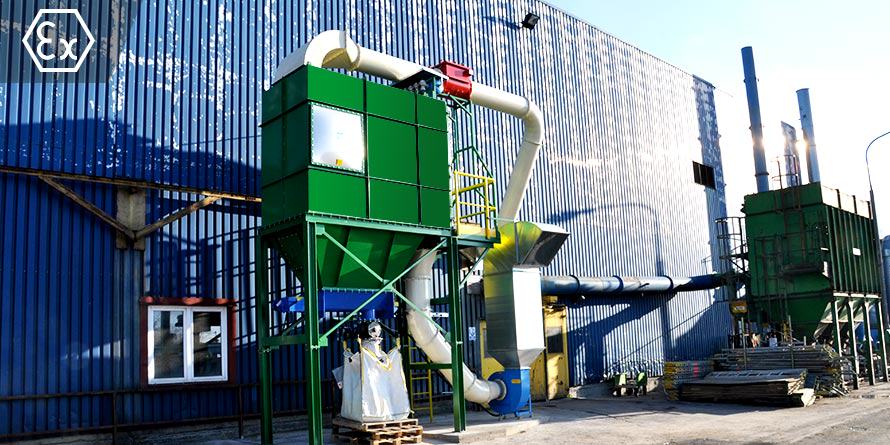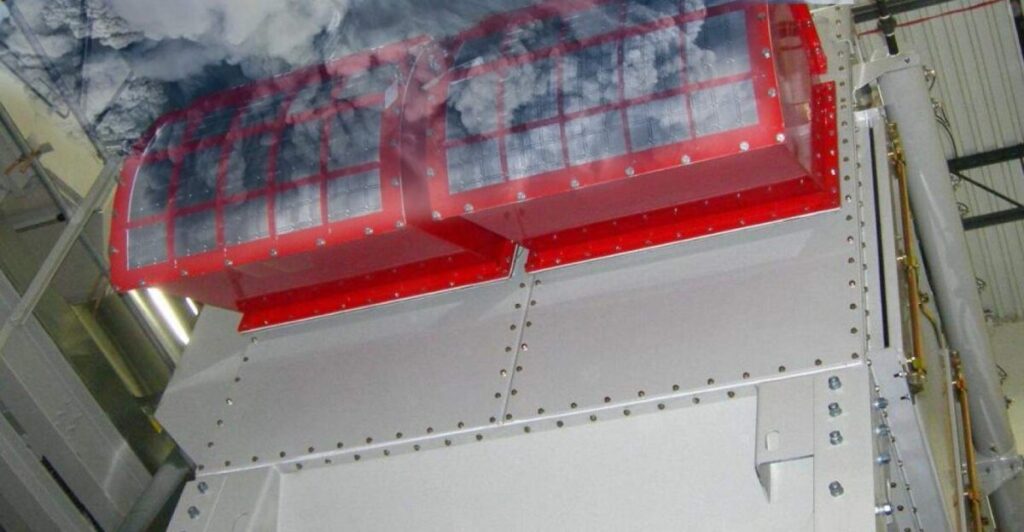Given these benefits of flameless explosion relief, two questions may stand: what is the purpose of using decompression panels? and, is it possible to replace the already installed decompression panels with a flameless explosion relief system?
The answer to the first question is very simple – the main reason for using decompression panels is their low price. If there are no limitations typical of decompression panels, they often are our recommendation for a project.
The second question which concerns replacement of decompression panels with flameless explosion relief demands an answer which is a tad more complicated.
There is no ‘direct swap’
If a filter, a cyclone separator, a dryer, or another piece of equipment was designed to accommodate a decompression panel, a direct replacement of the component with a flameless explosion relief system is not feasible. This is because of the different efficiencies of the two solutions.
The decompression panel effective area is approximately 98% of the component. In a flameless explosion relief system, the effective area is approximately 60%.
Let us assume that we need to vent an explosion with a single decompression panel the effective decompression area of which is 1 m2. If we were to replace this panel with a flameless explosion relief solution which would occupy the same installation area, the effective decompression area of the relief would be 0.6 m2, or 40% smaller than in the decompression panel. Consequentially, the explosion protection solution would be undersized, inefficient, and would most likely cause the explosion-protected unit to burst.
How to offset the lower efficiency of flameless explosion relief?
The effective decompression area necessary to safely release the explosion pressure is calculated from the parameters of particulate matter explosivity and the parameters of the explosion-protected unit. An important part of the calculation is the structural failure resistance of the protected unit. As a rule of thumb – the required effective decompression area increases as the structural failure resistance decreases.
It is logical – it is much easier to vent the pressure growing inside of a unit when the clear decompression opening size is 2 metres square than 2 centimetres square. In other words, the larger a decompression area is, the lower is the reduced pressure value during an explosion inside of a unit.
Given the above, two conclusions can be drawn. To replace a decompression panel with flameless explosion relief, we need to apply one of the following solutions:
- Two flameless explosion relief systems are installed, or a single one is installed, but with a sufficiently increased effective decompression area.
- The structural failure resistance of the explosion-protected unit is resistance to make flameless explosion relief, the decompression area of which is reduce, effective.
Reinforcing the equipment is the last resort
Note that the second solution given above is much more complicated, and happens often to be much more expensive. It is so because specific structural strength calculations must be run to determine the method of structural reinforcement. There is more, the reinforcement must be physically implemented. All this generates costs which often outbalance the cost savings of applying a smaller flameless explosion relief device.
On the other hand, it could happen so that installation of one large or two small flameless explosion relief systems is infeasible. For example, the available installation space is too small, or a larger decompression area will reduce too much of the service volume of the explosion-protected unit; the latter case is commonplace in silos, as already discussed in this article.
Explosion suppression
As already indicated here, some circumstances make it infeasible to use explosion venting based on decompression panels or flameless explosion relief systems. In spite of what may appear, there are many situations like these and we have itemized them below. More often than not, more than one can exist concurrently.
- The explosion-protected unit is in a sheltered room or the room’s internal volume to the unit’s internal volume ratio is less than 15.
- The explosion-protected unit is near other plant, workplaces, pedestrian ways, vehicular roads, and/or flammable stores, which make it impossible to set out a separate hazardous area.
- The weight of the flameless explosion relief system is too high to install the solution on the unit (an alternative for this include both explosion suppression and decompression panels).
- The combustible particulates or their combustion products are harmful.
- The unit’s structural configuration cannot accommodate decompression panels or flameless explosion relief.
- It is critical for the user that there is no risk of fire after explosion inside of the protected unit.
Costs
The costs of the solution are worth mentioning. Flameless explosion relief solutions can be as much as 10 times more expensive than decompression panels. For the sake of cost effectiveness, flameless explosion relief is feasible for units with an internal volume no higher than 10 m3 (and sometimes the limit is ten-odd cubic metres).
With larger units, the costs of flameless explosion relief begin to outweigh the costs of installing a complete explosion suppression system. Explosion suppression systems are effective insofar that they prevent an explosion altogether by suppressing it at the very initial stage; this greatly reduces the time needed to put the protected unit back in service if the system is triggered in comparison to flameless explosion relief, a solution which actually permits an explosion and fire to happen inside of the protected unit.
Not all systems are equal
Note that the explosion protection solutions vary in efficiency with the supplier. They also be encumbered with special restrictions, as proven by their certificates.
This discussion applies to explosion protections from a specific supplier and all numerical values are disclosed as indicative only; the general idea is more important here. In other words, every case needs to be considered separately with reference to the characteristics of the processing plant, the combustible particulate matter, and the performance parameters of the specific supplier’s explosion protections; this consideration can be driven with the logic presented in this article.









